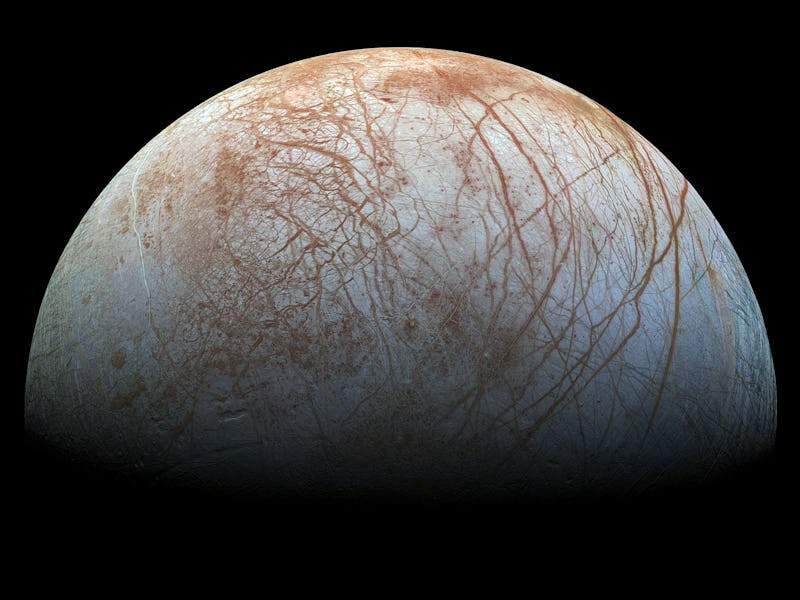NASA is set to make the nearest flyby Jupiter's most habitable moon in 22 years
All these worlds are yours, except...

A NASA spacecraft is about to give us the closest look yet at Jupiter’s icy, potentially habitable ocean moon Europa.
Early Thursday morning, NASA’s Juno spacecraft will skim just a couple of hundred miles above the frozen surface of Europa. Juno’s instruments will measure the composition of the moon’s thick icy crust, record how the upper layers of its thin oxygen atmosphere interact with Jupiter’s magnetic field, and snap the highest-resolution photos ever of Europa’s cracked, ridged surface. And if mission scientists are extremely lucky, Juno might even catch a plume of water venting out into space.
“We have the right equipment to do the job, but to capture a plume will require a lot of luck,” says Juno’s principal investigator, Scott Bolton of the Southwest Research Institute.
What’s New — During the flyby, Juno will pass just 358 kilometers (222 miles) from Europa — the closest any spacecraft has come to the icy moon since 2000, when the Galileo spacecraft flew just a few kilometers closer. And it’s the closest any spacecraft will get for almost another decade, so Juno is taking this chance to grab as much information as possible as it zooms past Europa at nearly 85,000 kilometers per hour (about 53,000 miles per hour).
“We are screaming by pretty fast,” says Juno’s deputy mission manager, John Bordi of the Jet Propulsion Laboratory. “All steps have to go like clockwork to successfully acquire our planned data.”
The Galileo spacecraft captured this image of Europa as it orbited Jupiter in the late 1990s.
That data will include details on the makeup of Europa’s 15 to 25-kilometer (10 to 15 mile) thick crust, which is mostly water ice but probably contains other compounds that could make or break the habitability of the liquid water ocean churning beneath the ice. And gathered along the edges of deep fissures in the ice, dark deposits of organic compounds could be samples of what lies beneath.
Juno’s microwave radiometer instrument will scan the ice, while a color camera called JunoCam will snap four high-resolution photos of the moon’s surface. Scientists will compare these brand new images to older ones from Galileo, looking for changes that could reveal more detail about whether Europa is tectonically active. Meanwhile, the Stellar Reference Unit — an onboard star-sighting camera whose usual job is navigation — will take a high-resolution black and white image of the moon’s surface, and the Jovian Infrared Auroral Mapper will capture images in infrared.
These photos will be lit by sunlight reflected from the upper cloud layers of nearby Jupiter. Without Jupiter’s brilliant glare, Europa’s surface would be in its own shadow at the time of the flyby.
The high-speed, low-altitude flyby isn’t just for science, though. Juno is getting a gravitational assist, or taking advantage of Europa’s gravity to alter its own speed for a closer orbit of Jupiter.
“Soon after the flyby is complete, the spacecraft needs to be reoriented for our upcoming close approach of Jupiter, which happens only seven-and-a-half hours later,” says Bordi.
Juno’s full suite of instruments and sensors, as shown in this NASA illustration, will be gathering data as it approaches Europa.
Why It Matters — Juno, launched in 2011, has been orbiting Jupiter since 2016. Although its primary focus is the gas giant itself, the spacecraft has also sent home reams of data on the whole system. Last summer, it swooped past Ganymede, and it’s scheduled for two flybys of volcanic, sulfurous Io in 2023 and 2024.
The information hurriedly gathered during Thursday’s brief flyby could help planetary scientists plan for the next mission to Europa: NASA’s Europa Clipper, which is scheduled to launch in 2024 and reach Europa by 2030. Europa Clipper will make about 50 flybys like this one, hopefully answering the question that’s on everyone’s mind about Europa: Is its ocean habitable? And does anything live there?
Europa Clipper will be sharing its Jovian neighborhood with the European Space Agency’s Jupiter Icy Moons Explorer, or JUICE, which is scheduled to launch in 2023 and arrive in Jupiter orbit sometime in 2031. As its name suggests, JUICE will study Jupiter’s three icy — and potentially habitable — moons: Europa, Ganymede, and the often-overlooked Callisto, which may also have a liquid water ocean beneath its icy crust.
But until at least 2030, Thursday’s flyby is the best look at Europa we’re going to get.